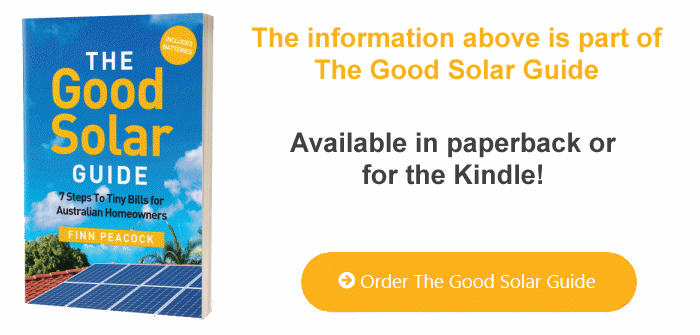STEP 7: After The Install
← Terms & Conditions | The Good Solar Guide Contents | Shifting Loads →
Your solar power system has been installed. What next?
Unless your solar installer is also qualified to work on your meter (usually, they’re not), you’ll have to wait for a separate sparky from your electricity retailer or network to come and reconfigure your meter to measure your exports. They may even need to give you a whole new meter.
If it isn’t part of your installation quote, this usually costs about $300. It’ll cost more if you have a three phase supply.
You are not normally allowed to switch your solar power system on until your new meter is installed. To help pass the time, you can do some simple checks of the install. I’m not recommending that you climb on the roof or try to do the job of a trained inspector, but there are simple things that can get overlooked. You can easily look for these and quickly get them put right so your system has the best chance possible of lasting 25 years or more.
Checking your install
Here are the things to look for.
On your wall
Check the following things:
- Inverters and isolators are protected from lengthy exposure to direct sunlight.
- Any outside, wall-mounted isolators do not have any electrical conduit entries from the top. This is a recipe for rain getting into the isolator, and that’s big trouble.
- The cables going into the solar inverter are neat and secured so they can’t be pulled or caught.
- All open conduits are sealed with a gland, not silicone.
- The inverter (or third-party monitoring system) is set to alert you if something goes wrong, so you don’t have to wait for the next bill to find out.
On your roof
If your house is single storey, you should be able to see all this from the ground – don’t go climbing up there unless you know what you’re doing.
- The solar panels are neatly lined up and level. Anything else is just plain lazy.
- Any excess rails are trimmed.
- No panels are overhanging or less than 200 mm from the edge of the roof. Positioning panels close to the edge is asking for the wind to get under and damage your roof or stress your panels. If the solar panels are too close to the gutter, the rain running off them can miss the gutter altogether. Online Resource: If you really need to go closer than 200mm to the edge of your roof – it is possible with the right racking and enough roof fixings. This post explains how: solarquotes.com.au/edge
- Any cables between panel arrays are not via an ugly, sun-exposed electrical conduit but through the roof cavity.
- The solar panel clamps are in ‘clamping zones’. The clamping zones vary between panel makes and models. Usually, each panel will have four clamps on the long sides and they need to be 100–300 mm from each corner. If the clamps are too far away from or too close to the corners, your panel can flex in the wind, cracking the silicon cells and drastically shortening its life. Online resource: Learn more about solar panel clamping zones here: solarquotes.com.au/cz
- If your quote and design assumed no shading, your panels should be unshaded throughout the day. Be wary of TV aerials, roof vents and flues.
- All rooftop isolators should be shielded from the sun.
- Any tilt-racking legs should usually be at right angles to the solar panels for maximum strength. If they aren’t, check that this is allowed by asking to see the racking manufacturer’s instructions, which will contain the relevant diagram. I’ve noticed that solar installers are excellent at electrics but they can miss a trick on the mechanical side of things, so this is worth checking.
Online resource: You can find an illustrated checklist with photos of good and bad installations for each point here: solarquotes.com.au/installcheck
Documentation
Sadly, many solar installers – even the good ones – don’t give documentation the priority it deserves, so you may have to hassle them for this.
Documentation is important because:
- you can refer to it if something goes wrong
- it shows you how to safely shut down and start up the system, and
- it tells you who to contact for warranties
If anyone comes to service or inspect your system, or do other electrical work on your house, it’s an important reference for them too. Moreover, the Australian Standard for solar installation says it has to be provided, so insist on a full documentation package.
This should include the following:
- List of equipment
- Warranty information – including which manufacturers to contact if the solar company disappears
- Equipment manual
- Equipment handbook
- Array frame or racking engineering certificate (proves mechanical safety)
- Shut-down and isolation procedure
- System performance estimate
- Maintenance requirements
- What to do if there’s an earth fault alarm
- System-connection diagram
- Site inspection checklist
- Testing and commissioning checklist
- Declaration of compliance
- Certificate of electrical safety
← Terms & Conditions | The Good Solar Guide Contents | Shifting Loads →
Questions or feedback about the content on this page? Contact me.
